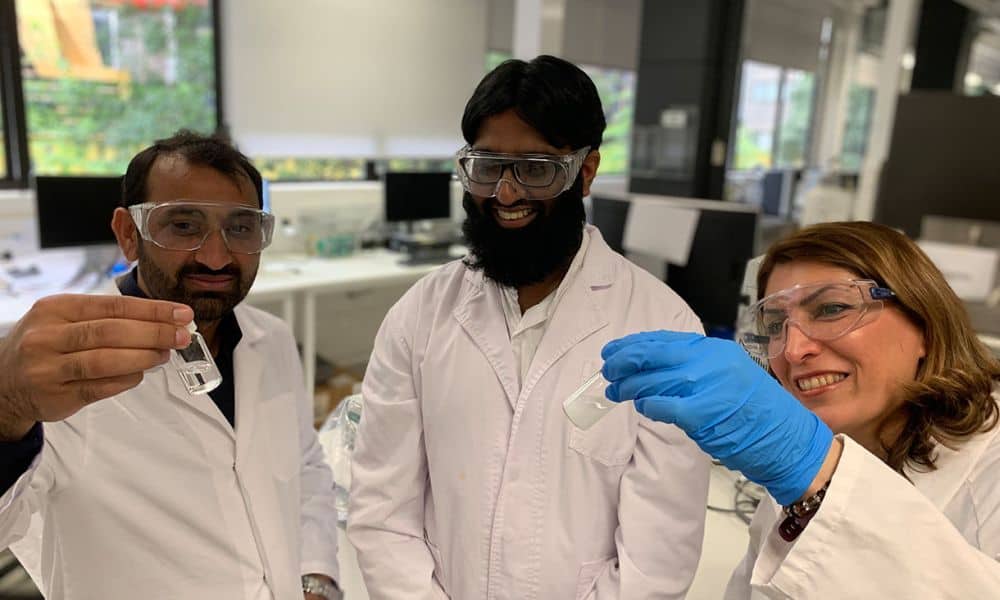
[Image above] (Left to right) Vice Chancellors Senior Research Fellow Nasir Mahmood, Ph.D. candidate Muhammad Haris, and professor Nicky Eshtiaghi with a sample of water with microplastics and a vial of clean water following its treatment with their innovation. Credit: RMIT University
Be it water, land, or sky, microplastics are inescapable in today’s world.
Microplastics are small pieces of plastic debris less than 5 mm (0.2 inch) in length. Primary microplastics are purposefully made that size (for example, microbeads in skincare products) while secondary microplastics are products of large plastics degrading over time.
Though the effects of microplastics on human health are not fully understood, the fact microplastics are now confirmed to be in our bloodstreams is a cause for concern among scientists. Thus, rather than wait and see what deleterious effects will manifest at higher microplastic levels, it is in our best interest to rein in this pollution as much as possible now.
While removing primary microplastics from cosmetics will help limit new microplastics entering the environment, we need to develop effective methods for removing the microplastics already there.
In a recent study, researchers from RMIT University in Australia developed an adsorptive method to remove microplastics from water.
Adsorption refers to the removal of microplastics by adhering them to an easily removable/retrievable surface called an adsorbent.
Metal-organic frameworks (MOFs) have recently gained attention as adsorbents due to their large surface area, pore-volume, and tunable properties.
Two-dimensional MOFs are of particular interest as they provide an opportunity to further tune the material’s surface chemistry and thereby increase adsorption effectiveness. However, fabricating and stacking 2D MOF sheets without compromising each sheet’s unique characteristics or risking their adhesion to each other (growth of a 3D structure) is challenging.
To overcome this challenge, the RMIT researchers used carbon encapsulated iron oxide nanopillars to separate the 2D MOF sheets. In addition to stabilizing the 2D MOF sheets, these nanopillars possessed a high surface area and unique surface chemistry, which the researchers hypothesized would aid in the efficient removal of microplastics as well as methylene blue, another toxic pollutant in industrial waste.
Microplastic removal was characterized using dynamic light scattering, ultraviolet–visible spectroscopy, and thermogravimetric analysis. Adsorbent stability was determined using ex situ microscopy, energy-dispersive X-ray spectroscopy, and Brunauer–Emmett–Teller theory.

Testing revealed that the nanopillar-stabilized MOF adsorbent could remove all microplastics and methylene blue in 60 minutes and 30 minutes, respectively, in systems containing only those contaminants. In systems containing both containments, 100% removal was achieved in 60 minutes. To verify reusability, the adsorbent was used in six consecutive adsorption cycles, where it maintained 90% removal efficiency.
“The results proved that [the nanopillar-stabilized MOF adsorbent] would not only be a substitute for classic filtration due to its convenient use, magnetic removal, and high adsorption capacity but also be effective for the removal of both solid and dissolved contaminants from water,” the researchers conclude.
In an RMIT University press release, the researchers say they are looking for industrial collaborators to take this invention to the next step, which includes testing the adsorbent in wastewater treatment plants.
The paper, published in Chemical Engineering Journal, is “Self-assembly of C@FeO nanopillars on 2D-MOF for simultaneous removal of microplastic and dissolved contaminants from water” (DOI: 10.1016/j.cej.2022.140390).
